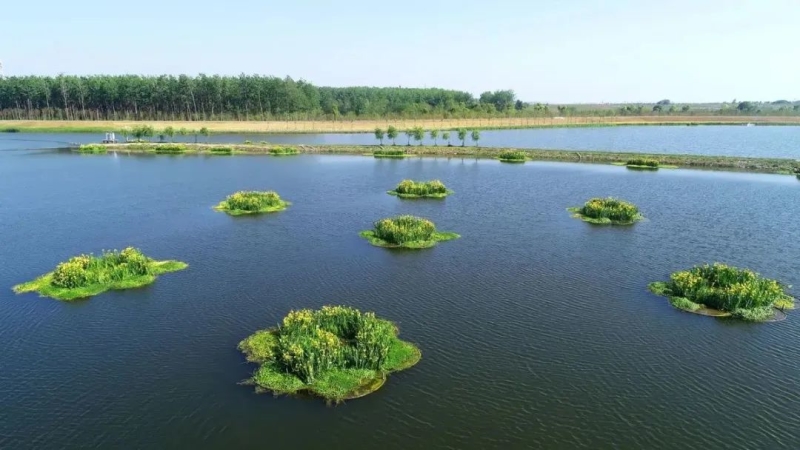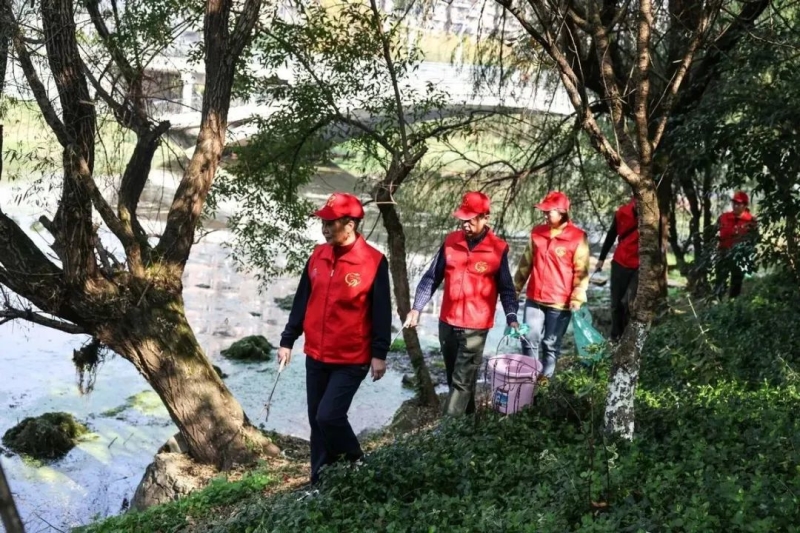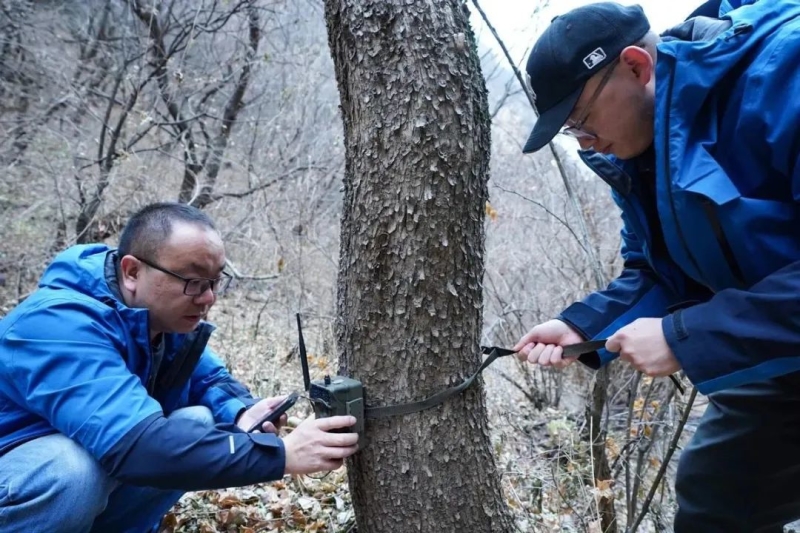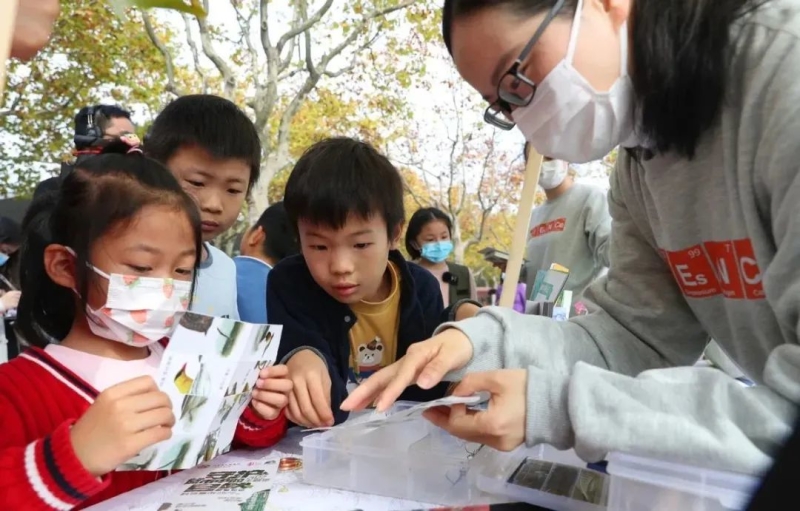COP15 president: Post-2020 biodiversity framework taking shape
Minister of Ecology and Environment Huang Runqiu talks with Erik Nilsson in his office in Beijing. JIANG DONG/CHINA DAILYEditor's note: The highly anticipated second phase of the 15th meeting of the Conference of the Parties to the UN Convention on Biological Diversity will soon start in Montreal, Canada. What should you expect? And what's China's role in the COP15 presidency?Erik Nilsson, a senior reporter of China Daily, talked with Huang Runqiu, COP15 president and China's minister of ecology and environment, about the upcoming conference and more.
Women catch fish amid blooming water lilies in a lake at a village in Morigaon district of India's northeastern state of Assam on Nov 6, 2022. [Photo/Xinhua]
Q1: This year marks the 30th anniversary of the UN Convention on Biological Diversity. In your view, why is biodiversity important? And what challenges does the world face in this respect?A1: As a Chinese saying goes, "All beings flourish when they live in harmony and receive nourishment from nature." Biodiversity lays the foundation for human survival and development.Our clothing, food, shelter, means of travel - every aspect of our material and cultural lives - are closely related to biodiversity. Biodiversity provides us with rich food, fresh air, clean water and the necessities for production and life such as clothing, lumber and raw materials for medicine and industry. It makes the Earth full of vigor and vitality, fertilizes the Earth like water and roots (nourish a plant) and lays the foundation for sustainable economic development.Data show that about half of global GDP is related to biodiversity. Over 3 billion people's livelihoods depend on marine and coastal biodiversity. Over 1.6 billion people's livelihoods depend on forests and non-lumber forest products. And about 70 percent of people living in poverty depend on activities like agriculture, fishing and forestry. As for healthcare, 70 percent of cancer drugs are natural products or originate from chemical compounds found in natural products.
Swans on the Qingshui River in Beijing's Miyun district on Nov 15, 2022. [Photo/Xinhua]
In addition, biodiversity plays an important role in maintaining the natural ecological balance, for instance, by fostering water sources, purifying the environment, conserving water and soil, preventing or mediating natural disasters, safeguarding food security and protecting human health.Over the years, the international community has become fully aware that biodiversity is of utmost importance and has acted to protect it.However, the deterioration of biodiversity has undergone no fundamental changes.In May 2019, the Intergovernmental Platform on Biodiversity and Ecosystems Services published a report. It shows that due to human activity, 75 percent of the Earth's terrestrial environment and 66 percent of its marine environment have been significantly altered, more than 85 percent of wetlands have been lost, and about one-fourth of species face the threat of extinction.The International Union for Conservation of Nature (IUCN) said in a 2020 report that 41 percent of amphibians, 26 percent of mammals and 14 percent of birds are threatened with extinction. The global biodiversity crisis is worsening.In the face of global biodiversity loss, we humans live in a community of a shared future and no country or organization or individual can remain immune.In 2021, President Xi Jinping delivered a keynote speech at the leaders' summit of the 15th meeting of the Conference of the Parties (COP15) to the Convention on Biological Diversity. He said that the international community must enhance cooperation, build consensus and pool strength to build a community of all life on Earth.Therefore, the international community should join hands to advance biodiversity protection, champion the harmonious coexistence between humans and nature, respect, adapt to and protect nature, promote global cooperation in biodiversity protection, and uphold multilateralism and the principle of equal consultation. Only in this way can it pool strength to protect biodiversity, realize win-win results and jointly build a better home.
A Yangtze finless porpoise jumps out of the water in the lower reaches of the Gezhouba Dam in Yichang, Hubei province, on Nov 9, 2022. [Photo/Xinhua]
Q2: Global biodiversity loss is accelerating. And this is a challenge for all humankind. What achievements has China made in recent years in this respect?A2: The Chinese government has always attached great importance to biodiversity protection and has made it a key part of the country's efforts to build an ecological civilization. In recent years, with the scientific guiding principle of Xi Jinping Thought on Ecological Civilization, we have continuously enhanced the top-level designs for biodiversity conservation, such as improvements of systems, mechanisms and regulations, and we have rolled out of a series of measures. We have made clear progress in conserving biodiversity and have earned international acclaim.For instance, the population of wild giant pandas has increased from 1,114 to 1,864. Their classification has been downgraded from "endangered" to "vulnerable". Last year, before the convening of COP15 in Yunnan province, a group of wandering wild elephants ventured northward in the province before returning to their original habitat.The Yangtze finless porpoises, which are known in China as the "smiling angels" because they appear to grin, have frequently appeared in different sections of the Yangtze River. Snow leopards have been frequently spotted in the Sanjiangyuan National Park. Marbled cats, which had not been seen for more than 30 years, have reappeared in the Gaoligong Mountains in Yunnan province. The population of wild Hainan black-crested gibbons has increased from fewer than 10 in two groups 40 years ago to 36 in five groups.In recent years, news about China's biodiversity protection has frequently made headlines. In our view, this progress can be attributed to several factors.First, we have improved the top-level biodiversity-protection designs. We have elevated the biodiversity protection to a national strategy in China. We have drafted or revised a series of relevant laws and regulations, have included biodiversity conservation in development plans for governments at the central and local levels and have actively pushed to mainstream such protections.Over the past decade, China has drafted and revised more than 20 laws and regulations pertinent to biodiversity conservation, including laws on forestry, grasslands, fisheries, wild animals, the environment, seeds, wetlands, the Yangtze River and biosecurity. We also rolled out the Opinions on Further Strengthening the Protection of Biological Diversity and implemented the China National Biodiversity Conservation Strategy and Action Plan (2011-30). Relevant departments also drew up regulations on the management of invasive species and issued lists of these species, improving prevention and control with good results.
Shiwuli River in Hefei, Anhui province, on April 28, 2020. [Photo/Xinhua]
Second, we have established a system of protected areas with a focus on national parks. To date, China has built its first five national parks, nearly 200 botanical gardens and 250 wildlife rehabilitation and breeding centers. China has established nearly 10,000 protected areas of all types and at all levels, accounting for about 18 percent of its total land area. In this respect, we fulfilled the 17 percent Aichi Target ahead of time.We have placed 74 percent of our key State-protected wildlife species under effective protection and have gradually rehabilitated the wild population of some rare and endangered species. In addition to the giant pandas and Hainan black-crested gibbons I mentioned just now, the crested ibis population has increased from only seven in 1981 to over 5,000 and the population of Tibetan antelopes has grown from 70,000 during the 1980s-1990s to more than 300,000. If you visit the Qinghai-Tibet Plateau, you can see the magnificent view of tens of thousands of antelopes galloping together. It's really spectacular.China has also set up a relatively complete ex-situ conservation system, including botanical gardens, germplasm-resource centers, gene banks and wildlife rehabilitation and breeding centers. Over 23,000 species of plants have been conserved, 112 species of rare and endangered wild plants native to China have been restored to their natural habitats and over 60 types of rare and endangered wild animals have been successfully bred.
Environmental protection volunteers patrol Huaxi National Wetland Park in Guiyang, Guizhou province on Nov 4, 2022. [Photo/Xinhua]
Third, we have strengthened the conservation and restoration of natural ecological spaces. We have taken the initiative to draw up ecological conservation red lines nationwide, which is an innovation, globally. The red lines cover zones that are critical to environmental function or are ecologically sensitive and stringent protection is enforced in those areas.They account for 31.7 percent of China's total land area and protect nearly 40 percent of the water-source conservation and flood-regulation functions, 32 percent of functions to fend off sandstorms and 45 percent of the carbon-storage function.We have also continuously launched major projects in biodiversity conservation and have pushed for the integrated conservation and systematic restoration of mountains, rivers, forests, farmlands, lakes, grasslands and deserts with annual investments of tens of billions of yuan. Our forest coverage and forest reserves have both maintained growth over the last 30 years. China's forest coverage reached 24.02 percent in 2021 and the country has realized the largest growth in forest resources among all countries in the world. Its ecological system has undergone steady improvements in its diversity, stability and sustainability.Fourth, we have continuously raised public awareness and encouraged social participation. We encourage the involvement of various parties, facilitate channels for their participation and improve incentive mechanisms.On important occasions, such as the International Day for Biological Diversity and World Environment Day, events are held to promote public awareness about biodiversity. Public awareness of, and participation in, biodiversity conservation are continuing to grow and an atmosphere in which everyone in society works to promote biodiversity conservation is gradually taking shape.
Workers at the Baihua Mountain Nature Reserve fasten an infrared camera for wildlife monitoring in Beijing on Nov 9, 2022. [Photo/Xinhua]
Q3: What is China doing to implement its plans?A3: The world is undergoing changes of a scale unseen in a century and the vision of building a community with a shared future for mankind has won broad support. Faced with the crises and challenges posed by biodiversity loss, we must firmly seize the important opportunity provided by COP15 to continue in the right direction of green and sustainable development, speed up the mainstreaming of biodiversity conservation and push for the start of a new chapter of biodiversity protection. To that end, China plans to make efforts in multiple fields.The first is to improve policies and regulations on biodiversity. We will conduct further research on policies and regulations related to conservation and cement the legal foundation for it.We will update the China National Biodiversity Conservation Strategy and Action Plan (2011-30) and improve the policy and system guarantees. We will actively study and plan for special legislation on biodiversity and make the legal system for biodiversity conservation more systematic and complete. We will enact solution-based laws in such areas as nature reserves and access to genetic resources and the fair and equitable sharing of the benefits arising from their utilization and we will improve corresponding supervisory systems. We will also strictly implement the Biosecurity Law, strengthen the environmental safety management of biotechnologies and continue to improve the prevention and control of invasive species.Second, we will continue to optimize the biodiversity conservation network and promote the systematic restoration of ecological spaces. We will continue to implement major projects for biodiversity conservation, step up the construction of a system of protected areas with national parks as the mainstay, strengthen the protection and supervision of key areas, such as the "red lines" for ecological conservation and priority areas for biodiversity conservation, and improve the ex-situ conservation system for rare and endangered animals and plants.We will coordinate and promote the holistic conservation and systematic restoration of mountains, rivers, forests, farmlands, lakes, grasslands and deserts and strengthen the ecological restoration of polluted water bodies, degraded ecosystems, abandoned mines and ecologically damaged areas.We will also focus on building a complete biodiversity-protection monitoring system, continuously carry out biodiversity background surveys, observation and evaluations, improve the technical standard system related to biodiversity surveying and monitoring and explore ways to establish technical systems for biodiversity evaluation, protection effectiveness assessment, etc.
Children play a bird-related puzzle game during an event promoting biodiversity protection in Shanghai's Century Park on Nov 20, 2022. [Photo/Xinhua]
Third, we will strengthen the sustainable use of biodiversity. Without good and sustainable utilization, it is difficult to achieve effective conservation. Therefore, we will build a whole-process, whole-chain and regular biodiversity protection and supervision mechanism and crack down on the illegal use of biological resources. We will strengthen technical research on the development and sustainable use of biological resources, guide and regulate biodiversity-friendly business activities, promote the development of green industries and franchising and build a high-quality and diversified ecological product system.Fourth, we will also deepen international cooperation and exchanges. We will incorporate the topic of biodiversity conservation into high-level international exchanges, promote international cooperation on the issue at high levels, actively participate in global biodiversity governance, honor the CBD and other international conventions, strengthen communication, enhance partnership recognition and promote global multilateral environmental governance according to the concept of building a shared future for all life on Earth.Last but not least, we will encourage public involvement. We need to innovate upon the means of popularization and education and enhance public awareness of and attention to biodiversity through the promotion of knowledge and concepts about biodiversity. We should set up more diversified participation channels, increase public participation, actively mobilize and encourage enterprises and social organizations to take part in biodiversity conservation and create an atmosphere in which everyone in society works to promote biodiversity conservation and sustainable use.In the future, we will also integrate the concept of biodiversity conservation into the whole process of building an ecological civilization, actively participate in global biodiversity governance and turn the Earth into a beautiful place for all creatures to live in harmony.Q4: The second phase of COP15, to be held in Montreal of Canada, will define and adopt the post-2020 Global Biodiversity Framework. Could you describe the consultation process, the results so far and the positive role that China has played during its presidency?A4: The main task of COP15's second phase is to draw upon past experiences in the development and implementation of previous global targets on biodiversity to formulate the post-2020 GBF. The aim is to put global biodiversity on a path to recovery by 2030, that is, to end the current situation of biodiversity loss.It can be said that the framework is a guiding political document for global biodiversity governance. There are also high hopes for the framework's adoption during the second phase of the meeting.At present, positive progress has been made in the framework's formation after negotiations and consultations during four rounds of working-group meetings. All parties have been seeking common ground while reserving differences and working in the same direction. There were sufficient exchanges and understandings about the issues and very comprehensive communication on the existing differences and suggestions.Currently, the structure and core content of the post-2020 GBF has been agreed upon, laying a solid foundation for finalizing a solution that is acceptable to all relevant parties.The CBD has 196 contracting parties and involves many international organizations and stakeholders. The consultations on, and negotiations of, the framework document involve all parties. So it is natural that the process is not all smooth and easy.There are still different requirements, even big differences, on some specific issues. For instance, the Convention has three main objectives: the conservation of biological diversity, the sustainable use of its components and the access to genetic resources and the fair and equitable sharing of the benefits arising from their utilization. We need to make more efforts to ensure the three objectives can be implemented in a comprehensive and balanced manner within the framework instead of overemphasizing one of them. And we have to work harder to narrow differences.There is also much work to be done to ensure the targets set by the framework are realistic yet ambitious, and practical and balanced and that they can help promote the sustainable recovery of biodiversity.In addition, the framework's realization ultimately depends on its implementation mechanism. For developing countries, the biggest concern is the mobilization of funds. Funding is obviously very important for the framework's application. It's an important and difficult part of the negotiations.
LI MIN/CHINA DAILY
Since assuming the COP15 presidency, China has actively exercised leadership and coordination in its efforts to advance negotiations of the post-2020 GBF. So far, China has convened a total of 37 COP15 meetings of the presidium. It has also presided over four meetings of the open-ended working group on the post-2020 GBF in such places as Geneva and Nairobi in collaboration with the CBD secretariat.China has made significant efforts to advance framework negotiations. The frequency of the meetings, especially the frequency of the presidium meetings, is quite rare in the process of multilateral environmental negotiations.Moreover, China has been using all sorts of occasions, such as the UN High-level Political Forum on Sustainable Development, the G20 Joint Environment and Climate Ministerial Meeting, the high-level week of the 77th session of the UN General Assembly and COP27 as opportunities to organize exchange activities on key COP15 issues in various forms, including high-level roundtables and briefings.We have also held frequent bilateral consultations with many other contracting parties to expand consensus. These efforts have both effectively maintained the political momentum of COP15 and facilitated the bridging of differences among contracting parties to achieve greater consensus.All parties recognized the great efforts made by China in the COP15 presidency in coordinating the positions of all parties and expressed their willingness to work with China to push for the adoption of an ambitious, practical and balanced post-2020 GBF.Although there are still many difficulties and demands in the consultations, all parties have expressed their firm political support and confidence in the negotiation process and China's role in the COP15 presidency.I am confident the international community will respond positively to the spirit of community embodied in the theme of the upcoming conference "Ecological Civilization: Building a Shared Future for All Life on Earth" and demonstrate the wisdom and courage to overcome these difficulties and differences.During the second phase of COP15, China will continue to play its presidency role well. With the support of the CBD secretariat, the presidium and the host country, China will work with fellow contracting parties, international organizations and stakeholders to spare no effort to advance the negotiation process, build the broadest possible consensus in the international community, promote the adoption of the framework and ensure the second phase of COP15 in Montreal is successful.







